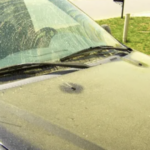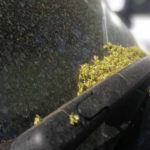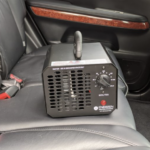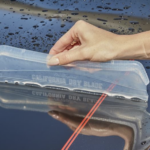How to Prevent and Remove Water Spots from Your Car’s Paint and Windows
Why Water Spots Are a Major Problem for Car Owners
Water spots are one of the most frustrating and difficult-to-remove issues that car owners face. They form when water evaporates, leaving behind mineral deposits that bond to the surface. Over time, these spots become etched into the paint and glass, making them harder to clean with basic washing.
Orlando’s hard water supply, frequent rain, and high humidity increase the risk of water spots. Vehicles parked outside or washed improperly often develop stubborn white stains on their paint, windows, and mirrors. If left untreated, these spots permanently etch into the clear coat, requiring professional correction.
What Causes Water Spots on Cars?
Water spots form due to mineral-rich water drying on the surface before it can be wiped away. There are three main types of water spots, each with different levels of damage:
- Regular water spots – These occur when tap water, rainwater, or sprinkler overspray evaporates, leaving behind mineral residue.
- Bonded mineral deposits – These are harder to remove because minerals become embedded into the surface.
- Etched-in water spots – The most severe type, where water minerals react with sunlight and burn into the paint or glass.
Cars that are washed in direct sunlight or parked under sprinklers are at higher risk of developing deeply embeddedwater stains.
How to Prevent Water Spots on Your Car
Preventing water spots requires a combination of proper washing techniques, drying methods, and protective coatings. Simple habits can make a big difference in keeping your car’s paint and glass free from stubborn stains.
1. Wash Your Car in the Shade
Washing in direct sunlight or high temperatures causes water to evaporate too quickly, increasing the likelihood of spots. Always wash your car early in the morning or late in the afternoon when temperatures are lower.
If shade isn’t available, use a car drying aid or quick detailer spray to prevent water from drying too fast.
2. Use Filtered or Deionized Water for Washing
Tap water contains high levels of calcium, magnesium, and other minerals that create water spots when left to dry. Using a filtered water system or deionized water reduces these contaminants, providing a spot-free rinse.
Many professional detailers use reverse osmosis or deionized water systems to prevent mineral buildup on vehicles. If washing at home, a water softener or inline water filter can help minimize spotting.
3. Dry Your Car Properly After Washing
Leaving your car to air dry is one of the biggest mistakes that lead to water spots. Always dry it using:
- A microfiber drying towel – Absorbs water without scratching.
- A dedicated car drying blower – Prevents water from pooling in crevices.
- A quick detailer spray – Adds lubrication and removes any residual spots.
Even after a light rain, drying your car immediately prevents water spots from forming.
4. Apply a Paint Sealant or Ceramic Coating
Sealants and ceramic coatings create a hydrophobic layer on your car’s surface, making it harder for water spots to bond.
- Paint sealants last 6-12 months and provide a slick, protective layer.
- Ceramic coatings offer long-term protection, lasting 2-5 years with proper maintenance.
A coated vehicle is much easier to clean, as water beads up and rolls off rather than drying into the paint.
How to Remove Water Spots from Your Car
If water spots have already formed, removing them requires the right techniques and products. Basic washing won’t work if the minerals have bonded to the surface.
1. Use White Vinegar for Light Water Spots
For mild water spots, white vinegar is an effective, natural solution. The acetic acid in vinegar helps dissolve mineral deposits without harming the paint.
How to use it:
- Mix equal parts white vinegar and distilled water in a spray bottle.
- Spray the solution onto the affected areas.
- Let it sit for a few minutes, then wipe with a microfiber cloth.
- Rinse thoroughly and dry the surface.
This method works best for fresh water spots that haven’t etched into the clear coat.
2. Try a Water Spot Remover Spray
For moderate water spots, a commercial water spot remover provides stronger cleaning power. These products contain acidic or chemical-based cleaners designed to break down stubborn mineral buildup.
Steps for removal:
- Apply a small amount of water spot remover onto a microfiber towel.
- Gently rub the affected area using light circular motions.
- Wipe away residue and rinse with water.
- Dry the surface completely to prevent new spots from forming.
Using a dedicated water spot remover prevents excess scrubbing, reducing the risk of micro-scratches.
3. Use a Clay Bar for Bonded Water Spots
If water spots feel rough to the touch, they have bonded to the surface and need to be removed using a clay bar treatment . This method lifts contaminants embedded in the paint.
Steps for clay bar treatment:
- Spray a clay lubricant or quick detailer onto the affected area.
- Gently rub the clay bar in straight lines, not circular motions.
- Wipe away residue and inspect the surface.
- Apply a sealant or wax to protect the paint.
A clay bar is especially effective on glass and mirrors, where water spots often accumulate.
4. Use Machine Polishing for Etched Water Spots
For severe water spot damage, where the minerals have etched into the paint, polishing is the only way to remove them. This process involves using a dual-action polisher and cutting compound to restore the finish.
Steps for paint correction:
- Apply a fine-cut polishing compound to a foam pad.
- Work the polish into the surface using medium pressure.
- Buff the area with a clean microfiber towel.
- Seal the paint with wax or ceramic coating for protection.
If the etching is too deep, professional paint correction may be required to fully restore the surface.
How to Keep Your Car Water-Spot Free
Regular maintenance and proper washing habits prevent water spots from damaging your paint and windows.
Best Practices for Preventing Water Spots:
- Wash and dry your car weekly to prevent mineral buildup.
- Avoid washing in direct sunlight to reduce quick evaporation.
- Park in a garage or shaded area to limit exposure to rain and sprinklers.
- Use a ceramic coating or paint sealant to protect against etching.
By taking these steps, you can keep your car’s paint and glass looking spotless while avoiding costly repairs in the future.
Final Thoughts: Keeping Water Spots Off Your Car for Good
Water spots are a common problem, but with the right prevention methods and cleaning techniques, they don’t have to ruin your car’s appearance. Whether using filtered water, drying properly, or applying protective coatings, maintaining your vehicle keeps it looking pristine year-round.
For those dealing with deeply etched spots or stubborn stains, professional detailing services offer advanced solutions that restore your paint and protect against future damage.
Keeping your car water-spot free doesn’t require expensive treatments—just consistent care, the right products, and good maintenance habits.
Leave a Comment Cancel Comment
Book Orlando Mobile Detailing
Search
Latest Post
-
 The Cost of Neglect: Why Regular Aircraft Detailing Saves Money in the Long Run
February 14, 2025
The Cost of Neglect: Why Regular Aircraft Detailing Saves Money in the Long Run
February 14, 2025
-
 Why Car Washes Aren’t Enough to Combat Pollen Damage
February 13, 2025
Why Car Washes Aren’t Enough to Combat Pollen Damage
February 13, 2025
-
 Orlando’s Pollen Problem: When Is It the Worst and How It Affects Your Car
February 13, 2025
Orlando’s Pollen Problem: When Is It the Worst and How It Affects Your Car
February 13, 2025
-
 How Ozone Generators Eliminate Stubborn Car Odors in Orlando
February 12, 2025
How Ozone Generators Eliminate Stubborn Car Odors in Orlando
February 12, 2025
-
 Why a Water Blade and Chamois Beat Towels Every Time!
February 9, 2025
Why a Water Blade and Chamois Beat Towels Every Time!
February 9, 2025
